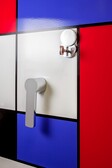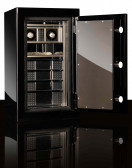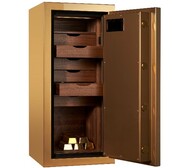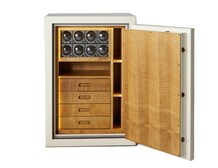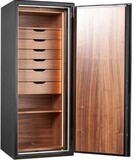Let's say you have already chosen a safe you are interested in. You know its security class, you have determined its size and weight, so you see a standard grey cuboid with an unromantic appearance, and suddenly you realise that this device will be the trustee of your treasures for a few years, maybe several. Every day you will look at it, touch its surface, squeeze the handle to open and close it. You will look inside and contemplate its interior. So let's consider which elements of the safe's design we are able to tailor to you and how to go about it.
Which lacquer to choose?
The first thing you will intuitively notice is the paintwork, or more precisely its colour. Most manufacturers offer RAL-based colour schemes. For you, this is a great convenience, because even without seeing the safe in person, you can see the colour of your choice in your nearest paint and varnish shop, also applied to a steel-like surface. As standard, the safes are offered in light grey, the RAL colour number 7035. This is a non-intrusive, neutral colour, which will suit both corporate and private environments. However, there is nothing to prevent you from deciding on a different colour, as the RAL palette offers a wide spectrum to choose from, ranging from subdued variations on the grey theme to bright and flashy colours native to the equatorial jungle. On request, the safe can even be made in two colours, e.g. black body and white door, or blue interior and orange exterior.
However, colour is not everything. The default way to paint the safe is using the powder method. To the touch, such a lacquer resembles an orange peel, is slightly rough and generally speaking not very pleasant. This is why for safes, especially high-end safes, we are increasingly offering painting by more innovative methods. The halfway point between classic and semi-matte texture is the so-called soft-touch effect, in which the lacquer gives the impression of being finer, smoother, softer. If you want a fine, smooth surface, the safe can be finished with a classic matt or high-gloss lacquer. If you additionally opt for a finer colour, you will get a particularly spectacular end result in combination with the high gloss.
Does the choice of lock matter?
Recently, we discussed the available locking options in terms of functionality and daily interaction with the device. Today, we will focus on the sensory experience that accompanies the use of locks. A video showing how to open an antique safe using an impressive combination of locks, mechanisms and latches gained considerable popularity on the Internet not too long ago. For one safe, you needed a whole and quite large bunch of keys. Fortunately, this is not the case with modern safes, which can be opened by turning the key in the lock with absolutely no sensation. Just an action.
A mechanical combination lock, on the other hand, is a completely different story. There are at least a couple of eye-catching dials which can be a lot of fun to turn. Many of our customers will attest to the fact that turning the solid steel knob left and right is a rewarding activity comparable to ending a telephone call by closing the flap. There are more and more foldable smartphones on the market, so perhaps this is also why the number of mechanical lock enthusiasts is growing (albeit slowly). Mechanical combination locks have their own charm, giving safes a classic, conservative look, especially if you add a matching handle, but more on that later.
The greatest choice, however, is among electronic locks. There are a few, perhaps a dozen, reputable lock manufacturers, each with their own style that those familiar with the industry will recognise without question. As a result, there is a good chance that it is in this category that you will find the most suitable model for your environment. Locks can vary, some conservative, others modern and minimalist. It will be up to you and the arrangement of your space to decide which fits best.
Despite the technical sophistication of locks, the method of opening and closing a safe is always the same – you have to turn the handle. The handle is the part of the safe that you will physically touch and look at most often, so it's worth knowing that, as with locks, there are quite a few models to choose from. For smaller safes, the common choice is the so-called huwil, which is a knocker-like handle. This is made of plastic, so it is best used with smaller safes and lighter doors. For larger safes, it is better to choose a solid handle. There are lighter or heavier handles, made in standard or chrome or even gold-plated.
Which safe interior to choose?
The standard feature of any safe are shelves adjustable in height every 5 cm, made of steel and powder-coated identically to the rest of the safe. Nothing fancy about that, so today we won't be interested in the default interior of a safe. So let our imagination run wild, because it's the custom-designed equipment that we like to deal with the most. Here we are only limited by your imagination and physical technical capabilities. If you appreciate classic and conservative solutions, we will make your interior out of warm white-lit wood, padding the drawers with alcantara or velour. It will be beautiful, soothing and gentle. On the other hand, you may be an enthusiast of frugal and industrial interiors, so perhaps stainless steel, glass and cool lighting would be more to your liking? What if the safe stands in a living room adorned with souvenirs from foreign trips, lion safaris and exotic jungles? Then have the interior made of eco-friendly leather imitating leopard spots or ivory. You can, why not? All options are open to you; we want you to get involved in this project. Tell us about your safe, draw it and we'll design and make it just the way you want it.
We also recommend: An exclusive safe – what is it?



